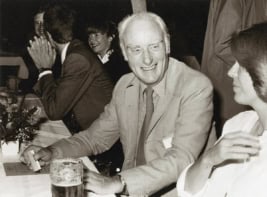
By Tushna Commissariat
So much has been said about Einstein and his general theory of relativity (GR) that one would assume there isn’t two entire days worth of talks and lectures that could shed new light on both the man and his work. But that is precisely what happened last weekend at Queen Mary University London’s “Einstein’s Legacy: Celebrating 100 years of General Relativity” conference, where a mix of scientists, writers and journalists talked about everything from the “physiology of GR” to light cones and black holes, to M-theory and even GR’s “sociological spin-offs”.
The opening talk, “Not so sudden genius”, was given by journalist and author of “Einstein: A hundred years of relativity“, Andrew Robinson. The talk was very fascinating and early on Robinson outlined that Einstein stood on the shoulders of many scientists and not just “giants” such as Newton and Mach. But he also acknowledged that the scientist was always a bit of a loner and he preferred it this way. Robinson rightly pointed out that until 1907, Einstein was “working in brilliant obscurity” and later, even once fame found him, rootlessness really suited Einstein’s personality – he described himself as “a vagabond and a wanderer”.
From one of the first day’s more sciency talks, I particularly enjoyed Cardiff physicist B Sathyaprakash’s lecture on “Gravitational waves: a new tool for observing the cosmos”. One of the more amazing facts that he pointed out is that, for a very short timespan, a pair of colliding black holes would be “more luminous in gravitational waves than the whole universe is in light”.
An excellent talk on Sunday morning was given by Katy Price, author of “Loving faster than light“. In her talk, she highlighted the many references to GR in everything from journalism to pulp-fiction, prose and poetry, soon after the theory was publicized. I was amazed but unsurprised to learn that everyone from P G Wodehouse to W H Auden referenced GR in their writing.
Of course, the main highlight of the conference were the Saturday evening plenary speakers – Cambridge’s John Barrow and Oxford’s Sir Roger Penrose. Barrow gave a fast-paced and amusing talk on “Einstein’s universe of universes” where he outlined all of the many solutions that GR allows and the different universe that arises from each one. His talk also revealed a previously unknown (to me at least) connection between cosmology and Google.
Sir Roger’s talk, titled “Light cones, black holes, infinity and beyond“, was equal parts complex, intriguing and amusing. His opening transparency (he is not fond of slideshows) was a dig at the black hole shown in Interstellar (which he did not like), while his sketches (pictured above) took us from singularities to black holes evaporating (with a pop!) to cyclic universes; all in whimsical, colourful detail. I had the good fortune to talk with Sir Roger after his lecture and ask him about his views on cosmology in the coming decade – keep an eye out for the video soon.
You can see all of our live Tweeting from each talk in this Storify article put together by the conference organizers and take a look at the hashtag #EL15.
Suffice to say that at the end of both days, I and my fellow participants were ready to quote Einstein himself when, after finally completing his field equations for GR, he allegedly signed himself off in a letter to a friend as “contented but kaput”.



